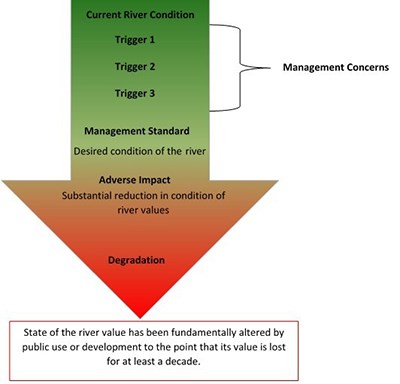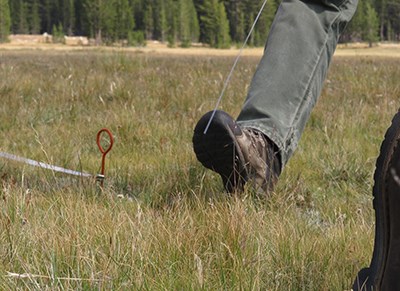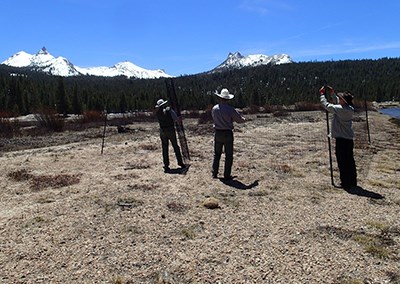
Visitor Use ProgramHow are the ORVs Monitored?For each ORV, the park resource experts determined at least one measurable indicator to track its condition. They then developed a systematic measurement protocol to monitor each indicator. For each measure they developed standards to maintain the biophysical, cultural, and social conditions defined within the Merced and Tuolumne Wild and Scenic River Plans. For example, ORV 1 consists of the high elevation meadows and riparian habitats that are above Nevada Fall near the headwaters of the Merced River. There are three indicators that provide insight into the health of these areas:
These indicators measure characteristics that are sensitive to human impacts, but they are not meant to provide a detailed assessment of the ORV. Rather the indicators signal is there is a necessity for a closer look that includes evaluating the cause of an impact. Determining the cause involves first understanding the context, second monitoring relevant parameters, and third determining the necessity for increased monitoring or taking a direct management action. 
At the time that the Merced River Plan (MRP) and Tuolumne River Plan (TRP) were published, the condition of the majority of river values (ORVs) were better than the identified management standards. Each plan laid out actions to improve ORVs that did not meet management standards and to protect and enhance all ORVs through regular monitoring of their condition. To ensure early detection of potential impacts to the river value, incremental standards are used, known as trigger points. Management concerns represent the phases of deterioration towards the management standard and are marked by trigger points that have been identified above the management standard. The diagram displays the progression of defined conditions. 
For example, bare soil (Indicator 1 for ORV 1) is measured using the percent of bare soil in a meadow. A meadow with a bare soil percent above 13 is considered in low condition and trips trigger point 1. The management standard for bare soil states that at least 75% of sites monitored must be in high ecological condition and no more than 15% of sites should be in low ecological condition. Tripping trigger point 1 signals a management concern since one meadow in low condition could begin a trend of meadows in low condition approaching the 15% threshold of the management standard. 
Using trigger points prevents the ORV from dropping below the management standard and experiencing an adverse impact. An adverse impact is a substantial reduction in the condition of the river value within an entire river segment due to public use or development. In the case of bare soil, an adverse impact could occur if a group of rafters create a new informal route to the river through a meadow. This could begin a trend along an entire river segment of groups of people walking across meadows with their gear. If management acts when the first area is impacted by rerouting the rafters to an existing trail, further deterioration is prevented and vegetation will recover naturally. If management does not act, the river value could experience deterioration where all the vegetation in the segment of the river is trampled and improvement would require closure of the whole section and implementation of a revegetation project. Degradation occurs when the value is fundamentally altered by public use to the point that its’ value is lost for at least a decade. 
Management ActionsWhen a trigger point is reached, park managers respond by implementing the actions listed in the wild and scenic river planning documents. The actions are intended to limit further impacts to the integrity of river values and reverse deterioration. Management actions include activities such as increased monitoring, secondary measurements and studies, visitor education and outreach, and ecological restoration. In the case of bare soil, the resulting action could be a secondary assessment to confirm if the low condition is human caused. If it is clear that the source of the impact is from visitor use, the park could then provide increased education to meadow users. Management standards, adverse impact, and degradation are defined for each ORV. Resources are monitored every one to five years depending on the indicator and the level of use. Using indicator monitoring and defined trigger points prevents the ORV from reaching a degraded state. GlossaryIndicator: a measureable trait that is relevant to the condition of the river value being tracked, can be consistently measured, and is sensitive enough to provide early warnings of change. Management Standard: The condition of each ORV that must be maintained. The standard establishes the measureable threshold for the indicator (e.g. there would be no more than X number of parties encountered along a designated trail section per hour). The condition of most ORVs when the plan was initiated was higher than their management standards. Trigger Points: A trigger point is a measured level above the management standard that signals park managers to take actions to protect the identified resource so that standards are not violated. Management Concern: When monitoring indicates that the condition of a river value has reached a specific trigger point. Adverse Impact: A substantial reduction in the condition of a river value in relation to the management standard as a result of public use or development. An adverse impact is a segment wide condition and requires immediate attention by the agency. Degradation: The state in which a river value has been fundamentally altered by public use or development to the point that its value is lost for at least a decade. Degradation is a long term condition that is segment wide. Wild Classification: Rivers or sections of rivers that are free of impoundment and generally inaccessible except by trail, with watersheds or shorelines essentially primitive and water unpolluted. These represent vestiges of primitive America. Scenic Classification: Rivers or sections of rivers that are free of impoundments, with shorelines or watersheds still largely primitive and shorelines largely undeveloped, but accessible in places by roads. Recreational Classification: Rivers or sections of rivers readily accessible by road or railroad that may have some development along their shorelines, and may have undergone some impoundment or diversion in the past. |
Last updated: August 2, 2021
